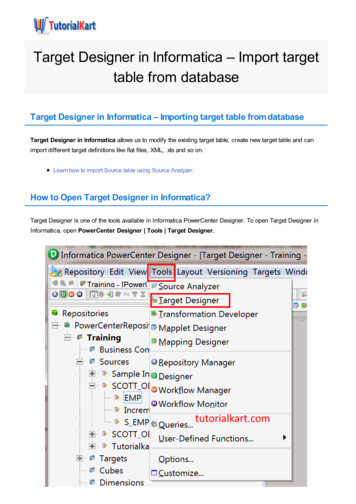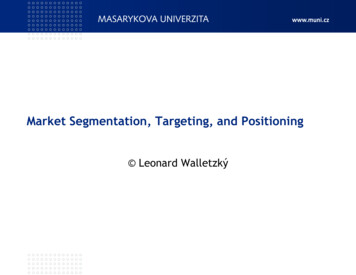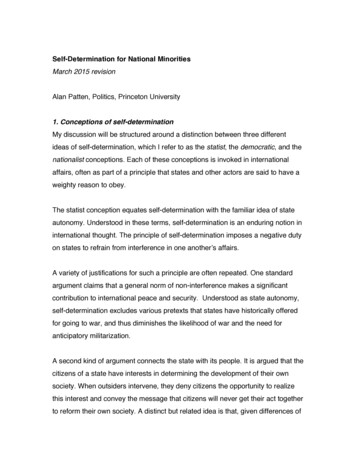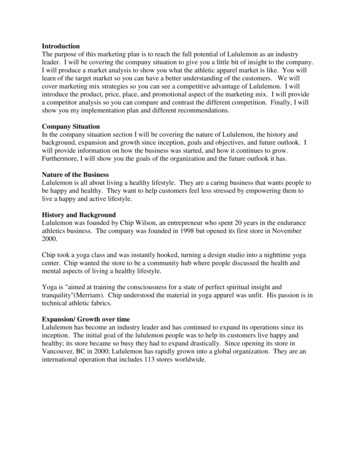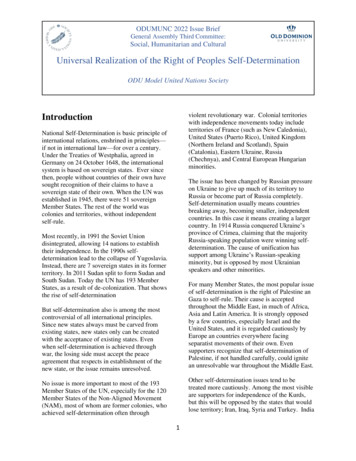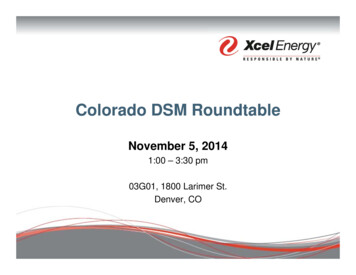
Transcription
1Target Market Determination — Funds ManagementLegal disclaimerThis Target Market Determination (TMD) is required under section 994B of the Corporations Act 2001 (Cth) (the Act).It sets out the class of consumers for whom the product, including its key attributes, would likely be consistent withtheir likely objectives, financial situation and needs. In addition, the TMD outlines the triggers to review the targetmarket and certain other information. It f orms part of State Street Global Advisors, Australia Services Limited’sdesign and distribution arrangements for the product.This document is not a product disclosure statement and is not a summary of the product features or terms of theproduct. This document does not take into account any person’s individual objectives, financial situation or needs.Persons interested in acquiring this product should carefully read the Product Disclosure Statement (PDS) for theSPDR S&P World ex Australia Carbon Control (Hedged) Fund before making a decision whether to buy thisproduct.Important terms used in this TMD are defined in the TMD Definitions which supplements this document. Capitalisedterms have the meaning given to them in the product’s PDS, unless otherwise defined. The PDS can be obtained byvisiting our website ssga.com.Target Market SummaryThis product is likely to be appropriate for a consumer seeking capital growth over the long term to be usedas a core or satellite allocation within a portfolio where the consumer has a medium term investmenttimeframe, very high risk/return profile and needs daily access to capital.Fund and Issuer identifiersIssuerState Street Global Advisors, Australia Services LimitedIssuer ABN16 108 671 441Issuer AFSL274900FundSPDR S&P World ex Australia Carbon Control (Hedged)FundARSN161 917 899ISIN CodeAU00000WXHG6Market Identifier CodeXASXProduct Exchange codeWXHGDate TMD approved1 February 2022TMD Version2TMD StatusCurrent
2Description of Target MarketTMD indicator keyThe Consumer Attributes for which the product is likely to be appropriate have been assessed using ared/amber/green rating methodology with appropriate colour coding:In target marketPotentially in target marketNot considered in target marketInstructionsIn the tables below, Column 1, Consumer Attributes, indicates a description of the likely objectives, financial situationand needs of the class of consumers that are considering this product. Column 2, TMD indicator, indicates whether aconsumer meeting the attribute in column 1 is likely to be in the target market for this product.Generally, a consumer is unlikely to be in the target market for the product if: one or more of their Consumer Attributes correspond to a red rating, orthree or more of their Consumer Attributes correspond to an amber rating.Investment products and diversificationA consumer (or class of consumer) may intend to hold a product as part of a diversified portfolio (typically with anintended product use of satellite/small allocation or core component). In such circumstances, the product should beassessed against the consumer’s attributes for the relevant portion of the portfolio, rather than the consumer’sportfolio as a whole. For example, a consumer may seek to construct a conservative portfolio with a satellite/smallallocation to growth assets. In this case, it may be likely that a product with a High or Very High risk/return profile isconsistent with the consumer’s objectives for that allocation notwithstanding that the risk/return profile of the consumeras a whole is Low or Medium. In making this assessment, distributors should consider all features of a product(including its key attributes).Consumer AttributesTMD IndicatorProduct description including key attributesConsumer’s investment objectiveCapital GrowthCapital PreservationCapital GuaranteedIncome DistributionThe Fund seeks to closely track, before fees and expenses,the returns of the S&P Developed Ex-Australia LargeMidCapCarbon Control AUD Hedged Index.The Fund is suitable for investors seeking capital growth overthe long term.The Fund generally distributes income annually.Consumer’s intended product use (% of Investable Assets)Solution/Standalone (75–100%)Core Component (25–75%)Satellite/small allocation ( 25%)The Fund achieves its exposure to a diversified portfolio oflarge and mid-cap stocks across developed market countriesthough an investment in the SPDR S&P World ex AustraliaFund while fully hedging its exposure to foreign currencyvolatility on equity returns.Consumer’s investment timeframeShort ( 2 years)Medium ( 2 years)The minimum suggested timeframe for holding investments inthe Fund is 5 yearsLong ( 8 years)Consumer’s Risk (ability to bear loss) and Return profileLowMediumHighThe Fund has a very high risk profile and seeks to closelytrack, before fees and expenses, the returns of the S&PDeveloped Ex-Australia LargeMidCap Carbon Control AUDHedged Index.
3Consumer AttributesTMD IndicatorProduct description including key attributesVery highConsumer’s need to withdraw moneyDailyUnit holders can sell their units on the Australian SecuritiesExchange.WeeklyMonthlyQuarterlyAnnually or longerAppropriatenessThe Issuer has assessed the product and formed the view that the product, including its key attributes, is likely to beconsistent with the likely objectives, financial situation and needs of consumers in the target market as describedabove, as the features of this product in Column 3 of the table above are likely to be suitable for consumers with theattributes identified with a green TMD Indicator in Column 2.Distribution conditions/restrictionsDistribution ConditionDistribution Condition RationaleThere are no distribution conditionsapplicable Review triggersThis part is required under section 994B(5)(d) of the Act.Material change to key attributes, fund investment objective and/or fees.Material deviation from benchmark/objective over sustained period.Key attributes have not performed as disclosed by a material degree and for a material period.Determination by the issuer of an ASIC reportable Significant Dealing.Material or unexpectedly high number of complaints (as defined in section 994A(1) of the Act) about the product or distribution ofthe product.The use of Product Intervention Powers, regulator orders or directions that affects the product.Mandatory review periodsReview periodMaximum period for reviewInitial review1 year and 3 monthsSubsequent review3 years and 3 monthsDistributor reporting requirementsReporting requirementReporting periodWhich distributorsthis requirement applies toComplaints (as defined in section 994A(1) of the Act)relating to the product design, product availability anddistribution. The distributor should provide all the content ofthe complaint, having regard to privacy.Within 10 business days following endof calendar quarterAll distributorsIf practicable, distributors should adopt the FSC data standards for reports to the issuer. Distributors must report toState Street Global Advisors, Australia Services Limited using the email address: ddo@ssga.com.
4Issued by State Street Global Advisors, Australia Services Limited (AFSL Number 274900, ABN 16 108 671 441) ("SSGA, ASL"). Registered office:Level 14, 420 George Street, Sydney, NSW 2000, Australia. Telephone: 612 9240-7600. Web: ssga.com.SSGA, ASL is the issuer of interests and the Responsible Entity for the ETFs which are Australian registered managed investment schemes quotedon the AQUA market of the ASX or listed on the ASX.This material is general information only and does not take into account your individual objectives, financial situation or needs and you shouldconsider whether it is appropriate for you. You should seek professional advice and consider the product disclosure document, available atssga.com, before deciding whether to acquire or continue to hold units in an ETF.Investing involves risk including the risk of loss of principal. Risk associated with equity investing includes stock values which may fluctuate inresponse to the activities of individual companies and general market and economic conditions. Please refer to the product disclosure document forthe specific risks associated with investing in the fund.SPDR and Standard & Poor's S&P indices are trademarks of Standard & Poor's Financial Services LLC and have been licensed for use by StateStreet Corporation. MSCI indices, the property of MSCI, Inc. ("MSCI") has been licensed for use by SSGA, ASL. SPDR products are not sponsored,endorsed, sold or promoted by any of these entities and none of these entities bear any liability with respect to the ETFs or make anyrepresentation, warranty or condition regarding the advisability of buying, selling or holding units in the ETFs issued by SSGA, ASL.This material should not be considered a solicitation to buy or sell a security and investors should obtain independent financial and otherprofessional advice before making investment decisions. There is no representation or warranty as to the currency or accuracy of, nor liability for,decisions based on such information.The whole or any part of this work may not be reproduced, copied or transmitted or any of its contents disclosed to third parties without SSGAAustralia’s express written consent. 2021 State Street Corporation — All Rights Reserved.
5TMD DefinitionsTermDefinitionConsumer’s investment objectiveCapital GrowthThe consumer seeks to invest in a product designed to generate capital return. Theconsumer prefers exposure to growth assets (such as shares or property) or otherwiseseeks an investment return above the current inflation rate.Capital PreservationThe consumer seeks to invest in a product to reduce volatility and minimise loss in a marketdown-turn. The consumer prefers exposure to defensive assets (such as cash or fixedincome securities) that are generally lower in risk and less volatile than growth investments.Capital GuaranteedThe consumer seeks a guarantee or protection against capital loss whilst still seekingthe potential for capital growth (typically gained through a derivative arrangement).The consumer would likely understand the complexities, conditions and risks that areassociated with such products.Income DistributionThe consumer seeks to invest in a product designed to generate regular and/or tax-effectiveincome. The consumer prefers exposure to income-generating assets (typically, highdividend-yielding equities, fixed income securities and money market instruments).Consumer’s intended product use (% of Investable Assets)Solution/Standalone (75–100%)The consumer intends to hold the investment as either a part or the majority (up to 100%) oftheir total investable assets (see definition below). The consumer typically prefers exposureto a product with at least High portfolio diversification (see definitions below).Core Component (25–75%)The consumer intends to hold the investment as a major component, up to 75%, of their totalinvestable assets (see definition below). The consumer typically prefers exposure to aproduct with at least Medium portfolio diversification (see definitions below).Satellite ( 25%)The consumer intends to hold the investment as a smaller part of their total portfolio, as anindication it would be suitable for up to 25% of the total investable assets (see definitionbelow). The consumer is likely to be comfortable with exposure to a product with Lowportfolio diversification (see definitions below).Investable AssetsThose assets that the investor has available for investment, excluding the family home.Portfolio diversification (for completing the key product attribute section of consumer’s intended product use)LowSingle asset class, single country, low or moderate holdings of securities,e.g. high conviction Australian equities.Medium1–2 asset classes, single country, broad exposure within asset class, e.g. Australian equities“All Ords”.HighHighly diversified across either asset classes, countries or investment managers, e.g.Australian multi-manager balanced fund or global multi-asset product (or global equities).Consumer’s intended investment timeframeShort ( 2 years)The consumer has a short investment timeframe and may wish to redeem within two years.Medium ( 2 years)The consumer has a medium investment timeframe and is unlikely to redeem withintwo years.Long ( 8 years)The consumer has a long investment timeframe and is unlikely to redeem within eight years.Consumer’s Risk (ability to bear loss) and Return profileIssuers should undertake a comprehensive risk assessment for each product. The FSC recommends adoption of the Standard RiskMeasure (SRM) to calculate the likely number of negative annual returns over a 20 year period, using the guidance and methodologyoutlined in the Standard Risk Measure Guidance Paper For Trustees. SRM is not a complete assessment of risk and potential loss.For example, it does not detail important issues such as the potential size of a negative return or that a positive return could still be lessthan a consumer requires to meet their investment objectives/needs. Issuers may wish to supplement the SRM methodology by alsoconsidering other risk factors. For example, some products may use leverage, derivatives or short selling, may have liquidity orwithdrawal limitations, or otherwise may have a complex structure or increased investment risks, which should be documented togetherwith the SRM to substantiate the product risk rating.A consumer’s desired product return profile would generally take into account the impact of fees, costs and taxes.
6TermDefinitionLowThe consumer is conservative or low risk in nature, seeks to minimise potential losses(e.g. has the ability to bear up to 1 negative return over a 20 year period (SRM 1 to 2)) andis comfortable with a low target return profile.Consumer typically prefers defensive assets such as cash and fixed income.MediumThe consumer is moderate or medium risk in nature, seeking to minimise potential losses(e.g. has the ability to bear up to 4 negative returns over a 20 year period (SRM 3 to 5)) andcomfortable with a moderate target return profile.Consumer typically prefers a balance of growth assets such as shares, property andalternative assets and defensive assets such as cash and fixed income.HighThe consumer is higher risk in nature and can accept higher potential losses (e.g. has theability to bear up to 6 negative returns over a 20 year period (SRM 6)) in order to target ahigher target return profile.Consumer typically prefers predominantly growth assets such as shares, property andalternative assets with only a smaller or moderate holding in defensive assets such as cashand fixed income.Very highThe consumer has a more aggressive or very high risk appetite, seeks to maximise returnsand can accept higher potential losses (e.g. has the ability to bear 6 or more negativereturns over a 20 year period (SRM 7) and possibly other risk factors, such as leverage).Consumer typically prefers growth assets such as shares, property and alternative assets.Consumer’s need to withdraw moneyIssuers should consider in the first instance the redemption request frequency under ordinary circumstances. However, the redemptionrequest frequency is not the only consideration when determining the ability to meet the investor’s requirement to access capital. To theextent that the liquidity of the underlying investments or possible liquidity constraints (e.g. ability to stagger or delay redemptions) couldimpact this, this is to be taken into consideration in completing this section.Daily/Weekly/Monthly/Quarterly/Annually or longerThe consumer seeks to invest in a product which permits redemption requests at thisfrequency under ordinary circumstances and the issuer is typically able to meet that requestwithin a reasonable period.
This Target Market Determination (TMD) is required under section 994B of the Corporations Act 2001 (Cth) (the Act). It sets out the class of consumers for whom the product, including its key attributes, would likely be consistent with their likely objectives, financial situation and needs. In addition, the TMD outlines the triggers to review .
